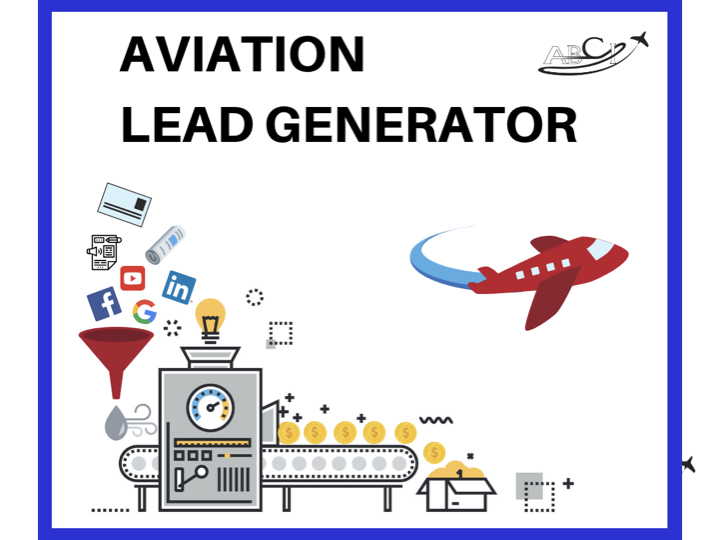You’ve heard of the Customer Life Cycle, but before we have a customer, we have to get prospects. And we can get more of them if we understand which parts our Prospecting Life Cycle are working and which are not!
[embedyt] https://www.youtube.com/watch?v=MGgWsFHYUFw[/embedyt]
Paula Williams: Welcome to this week’s episode. Today we are talking about the aviation prospecting life cycle, not necessarily the customer life cycle, which I’m sure you’ve heard of before, but-
John WIlliams: Of course.
Paula WIlliams: … the prospecting life cycle. So most of you have heard of the customer life cycle, right?
John Williams: I certainly hope.
Paula Williams: Exactly. But first of all, I’m Paula Williams.
John Williams: And I’m John Williams.
Paula Williams: And we are ABCI. And ABCI’s mission is …
John Williams: To help all you ladies and gentlemen out there sell more products and services in the aviation world-
Paula Williams: Absolutely.
John Williams: … at large.
Paula Williams: At large. Or at small.
John Williams: Small.
Paula Williams: I got so excited, we jumped into the topic before telling people who we are.
John Williams: See? See, there you are.
The Aviation Prospecting Life Cycle
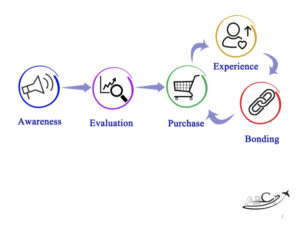 Paula Williams: [inaudible 00:00:47]. Okay, so customer life cycle, I’m sure you’ve seen this, in any marketing textbook you pick up, there’s some version of this.
Paula Williams: [inaudible 00:00:47]. Okay, so customer life cycle, I’m sure you’ve seen this, in any marketing textbook you pick up, there’s some version of this.
- People become aware of your product.
- They evaluate it against its competitors.
- They make a purchase.
- They have an experience with you.
- They bond with you.
- They tell their friends and neighbors, and so on.
- They purchase from you again if they had a good experience.
- They tell their friends and neighbors not to purchase from you if they had a bad experience, and so on.
So it goes around that cycle for as long as it goes. Right?
John Williams: Evidently.
Paula Williams: Right. So if you have a subscription product or something like that, then you’re reselling once a month. In the aviation industry, If you sell airplanes, if you’re a broker or whatever, then it might be three to five years as people go around that cycle. They don’t buy your planes every month unless …
John Williams: They’re really well.
Paula Williams: Right, unless you’re [crosstalk 00:01:39].
John Williams: The ashtrays get filled up.
Paula Williams: Oh, we don’t do ashtrays anymore, do we? Anyway.
John Williams: Okay. The bar needs to be refilled.
Paula Williams: The bar needs to be refilled. It’s dirty. You need the new airplane. But for the most part, people go through that cycle on a one-month basis, on a five-year basis, somewhere between the two. Right?
John Williams: Mmm-hm.
Where Do Aviation Customers Come From?
Paula Williams: Okay, cool. So let’s go back before that, before they even are aware of your product. While they’re going through that very first part of that cycle, where do they come from?
John Williams: Wherever they are.
Paula Williams: Wherever they are. Well, there’s a story about the stork, there’s this … all kinds of things, but we won’t get into that today. So anyway, this is a chart from our software, from Sharp Spring, and it talks about where our customers came from this month. And the biggest green section happened because of a postcard we sent out to MROs. Right?
John Williams: Ah, good point.
Paula Williams: Exactly. And then the next section-
John Williams: That’s instructive.
Paula Williams: Exactly. No, that’s really cool. The next section came from Google search, which is usually our biggest section, right?
John Williams: Mmm-hm.
Paula Williams: But this month is a little bit of an anomaly, but we throw the anomaly in because it’s instructive, right?
John Williams: That’s right.
Paula Williams: Okay. And we want to be real. So the next section, which is kind of turquoise, is from Google search. Now, what that is, is somebody typed in “aviation marketing,” or “digital marketing,” or “aviation digital marketing,” or “search engine optimization,” or something into Google, or “aviation postcards,” “aviation brochures.”.
John Williams: They happened to have a couple of keywords of ours in it.
Paula Williams: Exactly. And came to our website from Google. So that generally is the largest section of this pie.
The next smallest is from Facebook [crosstalk 00:03:32]-
John Williams: You missed direct traffic.
Paula Williams: Oh, yes, I missed direct traffic. I’m sorry.
John Williams: See how you are?
Paula Williams: Exactly.
John Williams: Somebody’s got to keep you straight.
Paula Williams: Okay. Direct traffic, that is people who knew about us some other way, and we don’t necessarily know how.
They may have a business card, or may have talked to them six months ago, or they came to one of our events and have our URL for some reason.
John Williams: Right. And they typed it in.
Paula Williams: Mmm-hm. Right. And then the next section is Facebook. So for those of you who think that Facebook doesn’t amount to a hill of beans, it certainly does.
John Williams: Small hill, but there it is.
Paula Williams: Small hill of beans, but we don’t spend much money or time.
John Williams: But that’s on this chart because of the MRO postcards we sent out.
Paula Williams: Exactly.
John Williams: On a typical chart, it would be larger.
Paula Williams: Exactly. Next section is word of mouth. And then the gray section is other. Now, we try to keep that gray section as small as we possibly can, but there are always people that find us and we have no idea how. Right?
If they interacted multiple times, which interaction was the most influential?
John Williams: Either they don’t recall when they talk to us or they don’t want to say, or whatever.
Paula Williams: Right, exactly. “I don’t remember how I heard of you the first time.” And that’s fine. We certainly don’t want to exclude those people, but we want to make that section as small as we possibly can because it’s best if we know how people found us the first time. Right?
John Williams: Exactly. The more we know, the better we can be.
Paula Williams: Exactly. So that pie chart is really helpful to figure out, how did people find you the first time? And if your software captures that, that’s great. But you have to help your software. So when someone calls you on the phone for the first time, one of the questions you ask them during that first conversation is …
John Williams: “How did you find us?”.
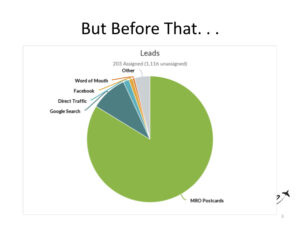 Paula Williams: Exactly. “How did you find us?” And you want to make sure that you get that information into your CRM, because it might be six months, or a year, or five years before they make a purchase from you.
Paula Williams: Exactly. “How did you find us?” And you want to make sure that you get that information into your CRM, because it might be six months, or a year, or five years before they make a purchase from you.
You want to have good records about how these people found you the first time. And you’re not going to remember. Right?
John Williams: Which is why you make notes.
Paula Williams: And they’re not going to remember either.
John Williams: No, they’re not.
Paula Williams: Exactly. Okay. So now let’s talk about, even if somebody found us on Google search … So that’s that turquoise section we were talking about.
John Williams: Mmm-hm.
Paula Williams: Okay, so we’re going to talk about a specific person who found us in that turquoise section. He found us on a Google search.
John Williams: Now, wait a minute, wait a minute.
Paula Williams: Okay.
John Williams: There are women that find us.
Paula Williams: There are women that find us.
John Williams: You said “him.”.
Paula Williams: I said him because I’m talking about a specific person, and I happen to know he’s a him.
John Williams: Oh, okay.
Paula Williams: Okay?
John Williams: So you are talking about [crosstalk 00:06:06]-
Paula Williams: I am.
John Williams: I see.
A Case Study – How A Customer Found ABCI
Paula Williams: Okay, so this is a specific guy, I’m pretty sure he’s a guy. I’ve talked to him on the phone. He’s got kind of a guy name, and he’s got a guy voice. So I’m making assumptions that he’s a guy.
John Williams: Okay.
Paula Williams: So I’m going to use those [crosstalk 00:06:21]-
John Williams: But you didn’t say that up front. So I mean, you know.
Paula Williams: All right. So anyway, this person, who happens to be a guy, found us on Google search.
John Williams: Okay.
Paula Williams: Okay. Then what he did is he used the little chat function on our website and he chatted with Jordan, asked some basic questions and things like that, and made an appointment. Right?
John Williams: True.
Paula Williams: Okay. During the time between that chat and an appointment, he listened to several of our podcasts.
John Williams: Really?
Paula Williams: Yeah. Okay. And then we had an appointment, and we had a really good conversation. And with this particular person, he purchased a service that we offer.
John Williams: Wow.
Paula Williams: Okay? So we have one, two, three, four, five steps, right?
John Williams: Yes.
Paula Williams: So Google search, chat, podcasts, appointment, and sale. Which of those … Actually we take out the sale. So there’s four steps other than the sale. Which of those four steps was the step that convinced him to purchase?
John Williams: Who the hell knows?
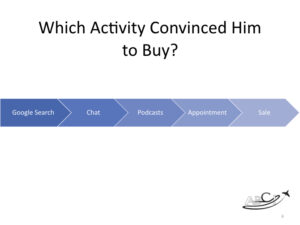 Paula Williams: Exactly. I mean, I don’t know. If I ask him-
Paula Williams: Exactly. I mean, I don’t know. If I ask him-
John Williams: He may not know.
Paula Williams: … he may not know. You know, “What was the one thing that put you over the edge to dig out your checkbook?”
John Williams: But I’d be willing to bet that if you took any one of those things out of there, the sale wouldn’t have been made.
Paula Williams: That is very likely. He may have gone to a competitor, or he may not have recognized the need for service, or whatever.
John Williams: As an aside, the chat function has only been on there about two months?
Paula Williams: Two months, yeah.
John Williams: And the first month, nothing happened, and we had started to take it off, and were convinced to leave it on for a while longer, and then this came along. So it’s paid for itself.
Paula Williams: Exactly. So all of those things, I don’t know, and he may not know which of those things actually caused him to dig out his, in this case, his credit card, and put the numbers into his computer.
John Williams: But he did.
Paula Williams: But he did. Right. So how do I work with this information not knowing which of those things was the thing that caused the sale? How do I know what to put more time and money into in our marketing portfolio?
John Williams: Well, I would say that Sharp Spring helps you do that.
Paula Williams: Okay. Thank you. So we’re going to go deeper into Sharp Spring.
John Williams: It was right.
“Life of the Lead”
Paula Williams: Exactly. Deeper into the software. And this shows me a thing called the life of the lead, right? So this tab says that we have had 40, 4-0, interactions with this person, which started … and it is only August, right?
John Williams: Really? 40?
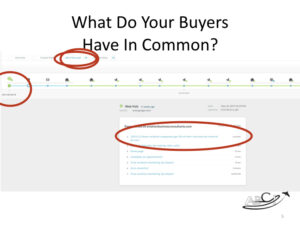 Paula Williams: Mmm-hm. It’s only August, and we started talking to this person in May. Okay? So he came to our website on May 18th and he visited these pages, and he spent-
Paula Williams: Mmm-hm. It’s only August, and we started talking to this person in May. Okay? So he came to our website on May 18th and he visited these pages, and he spent-
John Williams: So he found us on Google in May?
Paula Williams: He found us on Google by typing in something.
John Williams: I don’t care right now, but, so he found us in May on Google?
Paula Williams: Exactly. Right. So May 18th, he went to our website, and that’s what that little globe means, that little symbol in our software. And then the information that our software captured were that he spent nine minutes on our site on that day, and he spent six of those minutes on this particular article, Many Aviation Companies Get 50% Of Their Business By Referral.
John Williams: Do you?
Paula Williams: Do you? Right? So I suspect he was looking for referral marketing when he came to our site.
What I can do from this information is find out how many of our buyers … So at the end of 2019, I can look back and see how many of the people that bought from us visited this particular web page.
John Williams: Wow, cool.
Paula Williams: Yeah. And if that is the case, then we need to write more like that.
John Williams: Or keep that one out there.
Paula Williams: Well, yeah, obviously keep that one out there, or maybe even improve it, or spend some time spiffing up the search engine optimization of it so that more people find it.
John Williams: Right.
Paula Williams: Maybe add an infographic or a video or something to that page to do more of what’s working.
John Williams: Yes.
Double Down On The Investments that Work
Paula Williams: So this really helps us kind of target our investments into things that we know work. And this is a hypothetical, because I’m not looking back at the end of 2019, it’s only August. But that is a way that I could ask that question.
So in that life of that lead, once again, there are 40, 4-0, interactions. And that often happens between the different pages that they visit, the different emails that they open, the different media that we send them that they participate in, you know, they watch a video. All of that stuff you can see along this timeline.
And then of course we’ve got that data at the end of the year to look back and say, “Which were our most valuable and most convincing assets?”
John Williams: Well, the end of the year for us will only be nine months, right? Because we didn’t install Sharp Spring until-
Paula Williams: Until April. The longer we use it, the better it gets. Right?
John Williams: Of course. Next year at the end of the year, we’ll have a year’s worth of data.
Paula Williams: Exactly.
John Williams: Well, more than that because it keeps going.
Paula Williams: Right. Exactly. But keeping this level of data is really going to help us spend the time and money on what works.
John Williams: The things that work, and eliminate the things that don’t.
The Lead Generator Program
Paula Williams: Exactly. Right. So how can you make this work for you? We used a product called SharpSpring. That’s what we’ve been showing you during this episode.
John Williams: Right.
Paula Williams: And any CRM is only as good as the data that it captures.
So you need to configure it right, you need to get it connected to your website, you need to get it connected to your email, you need to, when you send out a postcard, you need to get those tagged so that those show up with the right tags on them saying this is how they found you.
If they get a postcard and then they come to your website, you want to keep all that information so [crosstalk 00:12:33]-
John Williams: And it will do that for you as long as you’ve got it configured correctly.
Paula Williams: Right. And every sales or marketing interaction is captured in this, whether it’s a phone call or whatever. So there is some entering of data, right?
John Williams: Mmm-hm.
Paula Williams: But for the most part, most of those 40 interactions, I would say probably 35 of them, at least, were automatically captured. So I’m not spending any time saying, “Which pages is this guy going to, and what is he doing on our website?”.
John Williams: And in fact, I think it has an interface into several types of telephone systems, if you’re large enough to have such.
Paula Williams: Exactly. And if you’re not, then you’re just going to have to log your phone calls.
John Williams: Exactly.
Paula Williams: Which still is a lot less work than otherwise. And hopefully you’re logging your phone calls anyway.
So Sharp Spring includes the CRM, the configuration, the setup. We set up your emails so that when people fill out a form on your website, they get an automatic email. All of that we set up custom for you the way you want it. And we do some digital marketing and other things so that you are getting those leads, so that you have something to keep track of. Right?
John Williams: Mmm-hm.
Paula Williams: So the Lead Generator is really the best way that we’ve found, for people who don’t really want to get into all the nuts and bolts of the technology, to be able to take advantage of-
John Williams: Of the technology.
Paula Williams: … the technology, and all of that information that you can use to make good decisions.
John Williams: Exactly.
Paula Williams: So it’s the software, plus the service. So you get ABCI’s famous service and Sharp Spring’s fabulous software in one package.
John Williams: Right.
Paula Williams: Okay. Great.
John Williams: Not to be confused with software as a service.
Paula Williams: Yeah, exactly, SaaS. This is actually real service plus software. Right?
John Williams: Right. Exactly.
Paula Williams: Okay. So thank you for joining us, and we’ll see you next week.
John Williams: Have a great day.
More Articles about Aviation Prospecting
AMHF 0011 – Advertising and Prospecting Basics
AMHF 0012 – Prospecting, Calls to Action & Lead Magnets
AMHF 0013 – 6 Prospecting Methods Using Aviation Digital Marketing
AMHF 0014 – Four Traditional Prospecting Methods
AMHF 0049 – How to Use LinkedIn for Prospecting in Aviation
AMHF 0050 – Power Prospecting – Aviation Marketing Book Club Discussion
Eight-Step, Never Fail Aviation Prospecting Method
This course was adapted from our Podcast, and enhanced with templates and worksheets. We’re offering it free for a limited time.
Why did we build this eight-step, fifteen-day prospecting campaign?
Because you have leads. (Or at least partial leads) But what you really need to sell more products and services is to book consultations.
We built this process from four sources:
- Our own practice (hence the examples!)
- Predictable Prospecting – How to Radically Increase Your B2B Pipeline by Marylou Tyler and Jeremy Donovan
- Magnetic Marketing by Dan S. Kennedy
- Email It! A Sellers Guide to Emails that Work by Bill Caskey
Podcast: Play in new window | Download
Subscribe: Spotify | Amazon Music | RSS

